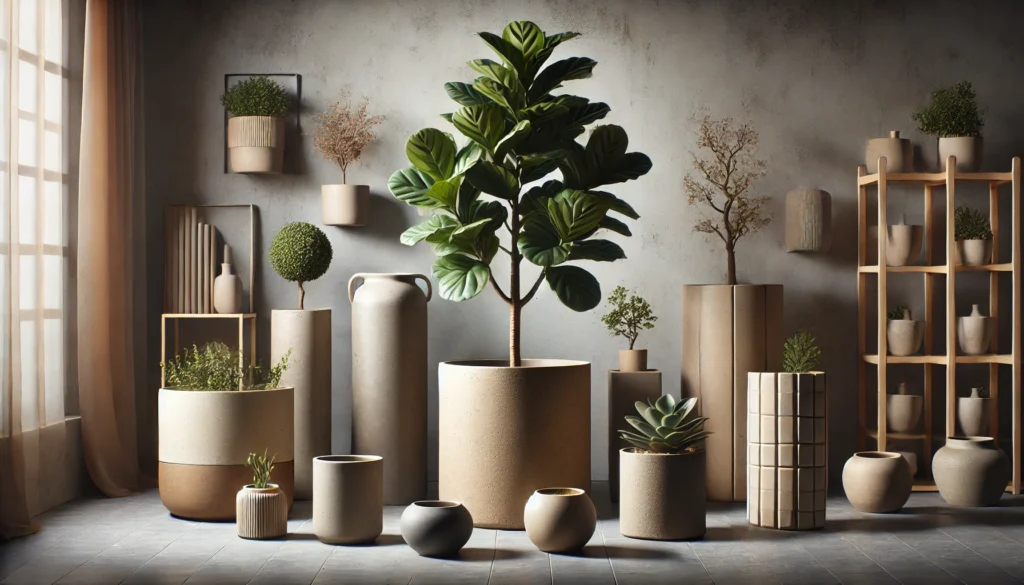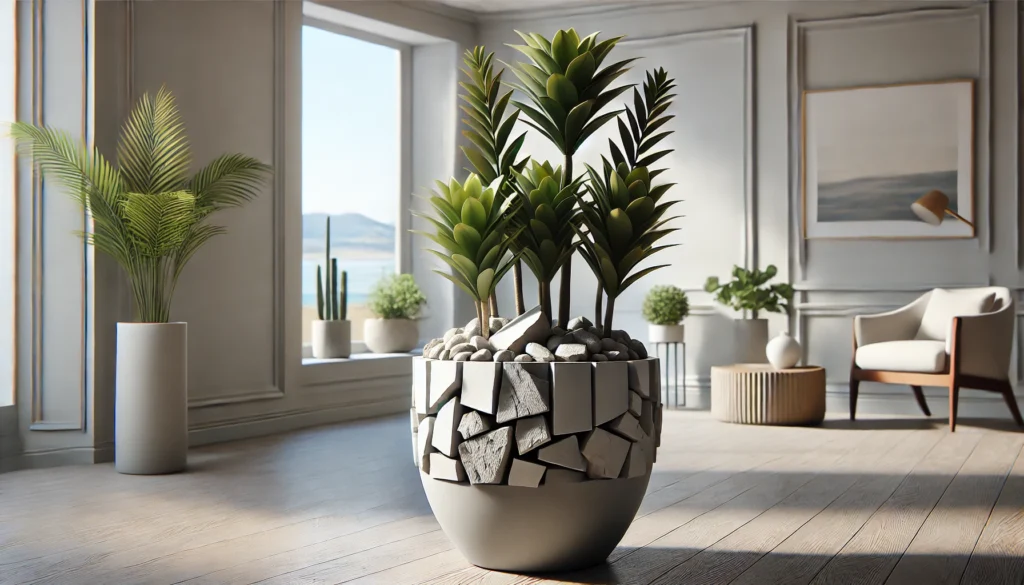Securing tall faux plants in a planter can be challenging, especially in high-traffic or outdoor settings where stability is key. From environmental factors like wind to accidental bumps, an unsteady artificial plant can tip easily, disrupting aesthetics and requiring constant adjustments. Below, well explore practical methods to secure faux plants, ensuring they stay upright and presentable in any environment.
– Tips to Secure Faux Plants in the Planter:
1. Choosing the Right Planter:
Selecting a suitable planter is fundamental to stability. A planter thats too small or light can easily tip, while an oversized planter may overshadow the plant. Heavier materials such as ceramic, stone, or concrete add inherent stability and reduce the need for extra weights. Additionally, ensure that the planters dimensions align with the plants height and width—an unbalanced planter can make even the sturdiest faux plants prone to toppling.

2. Positioning Faux Plants for Visual Impact and Stability:
Positioning your faux plant within the planter is another important factor for balance and visibility. You can start by filling the bottom of the planter with a layer of filler, such as sand or stones, to elevate the plants base. This initial layer helps stabilize the plant and ensures its foliage sits at the desired height. Add more filler around the plants base until the stem is securely surrounded to maintain stability and aesthetics.
3. Securing the Base of the Plant:
The right filler can transform a planters stability. There are some common materials like soil, sand, and decorative stones to select.
Soil: Soil is a convenient filler for faux plants because they are lightweight and easy to adjust. Its ideal for small plant. And it may lack the density needed for very tall plants.
Sand: Sand can add significant stability because of its heaviness. A layer of sand at the base is a good choice for large, tall plants prone to tipping.

Stones and Pebbles: Stones and pebbles can be layered at the top or mixed in with soil to increase weight. They provide a natural look and complement many faux plant styles while anchoring the planter.
For those looking to save on heavy fillers, consider layering lightweight materials, like packing peanuts or foam blocks, below a top layer of heavier fillers. This approach reduces costs while maintaining a sturdy base.
4. Structural Support Options: Cardboard and Other Props
Cardboard cylinders or other makeshift props can provide structural support inside the planter. Surround the faux plants stem with these cylindrical props, then fill in with soil or sand. This simple trick minimizes plant movement within the planter, keeping it upright without the need for glue or permanent modifications.
– How to Secure Tall Faux Plants in a Planter: A Step-by-Step Guide
Securing artificial plants in planters can be tricky. Many people resort to methods like loose weights or super glue. But that may not look appealing and can even damage the plant. Yet, leaving a tall faux plant unsecured increases the risk of it toppling over, especially if placed outside where wind, pets, or accidental bumps could knock it down. Heres a practical, aesthetic approach to securing your artificial plant correctly.

Step 1: Positioning Your Faux Plant in a Planter:
Tall faux plants often go in narrow, deep planters to create a striking look. This design helps elevate the greenery, but it also requires strategic placement to ensure its fully visible and balanced. Heres how:
Raise the Plant: You can start by adding a small amount of soil or filler material at the bottom of the planter to elevate the plant base.
Ensure Full Visibility: Position the faux plant in the center and cover the base with more soil or filler, allowing the entire plant to remain visible from the top of the planter without sinking too low.
Unlike real plants, artificial plants dont have roots to stabilize them, making the right weight distribution essential for stability.
Step 2: Weighing Down the Planter
There are several effective materials you can use to stabilize and secure a tall faux plant. Each method has its advantages depending on planter style and the look you want.

1. Use a Heavy Planter
You can opt for ceramic or stone planters, which are naturally heavier and provide a stable foundation. These types of planters typically wont require additional weights.
2. Match Planter and Plant Sizes
Ensure the planter size complements the height and weight of the artificial plant. A mismatch can make the plant more susceptible to tipping over.
3. Use Cardboard for Extra Support
For added stability, place cylindrical pieces of cardboard around the plants base inside the planter. This helps prop the plant up, making it less likely to shift.
4. Add Stone or Pebbles

Stone is a great option if you want a unique look. Broken stones layered at the top not only weigh down the planter but also enhance the plants presentation. Stones are heavier than soil and provide an extra level of stability.
5. Fill with Sand
Sand is an excellent choice for heavier weight distribution. Heavier than soil, it can keep even larger planters anchored in place.
– Preventing Tipping in High-Traffic or Outdoor Areas
1. Creating Wind and Movement Resistance:
Outdoor or high-traffic areas require additional considerations for plant stability. Wind can easily tip tall faux plants, so you need to weigh down the planter with heavy-duty materials. For even more support, consider securing the planter itself by anchoring it to a surface or attaching it to a weighted base. Inside busy commercial spaces, you can place planters near walls or other stable structures to minimize movement risk.
2. Using Decorative Elements for Added Weight and Style:
Decorative stones, artificial moss, or other heavy accessories add both weight and visual appeal to planters. Place a layer of stones or decorative gravel on top of the filler to anchor the plant and enhance its presentation. This technique allows you to achieve stability without compromising style, ideal for retail displays or design-oriented spaces.

3. Tips for Maintaining Long-Term Stability:
You can check on your faux plant setup regularly. It can save time and effort in the long run. Over time, fillers like sand or soil may settle, reducing the planters weight. Check stability every few months, especially in outdoor or high-traffic areas, and you can add filler as needed. Consistent maintenance ensures that your display remains secure, presentable, and hassle-free.
– Choosing the Right Faux Plant for Stability

Certain artificial plants are naturally more stable than others due to their structure and design. Opt for shorter, fuller plants if you prioritize stability. For taller plants, choose varieties with a thicker base or foliage that balances the plants weight. Matching the plants design to the planter and setting enhances overall stability, creating a reliable and eye-catching display.
Securing a tall faux plant in a planter requires thoughtful planning, from selecting the right planter to adding filler and choosing supportive accessories. By following these best practices, you can create a stable, visually appealing display that holds up in any environment.


